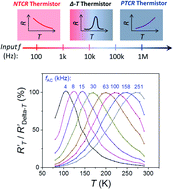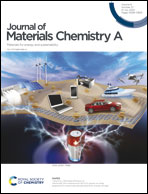Frequency switchable correlated transports in perovskite rare-earth nickelates†
Abstract
While electron correlations were previously recognized to result in direct current (DC) transportation properties beyond-conventional (e.g., metal-to-insulator transitions, bad metal, thermistors), their respective influences on the alternating current (AC) transport are largely overlooked. Herein, active regulation of the electronic functionalities of d-band correlated rare-earth nickelate (ReNiO3) thin films, by simply utilizing their electronic responses to AC-frequencies (fAC) is demonstrated. Assisted by temperature dependent near edge X-ray absorption fine structure analysis, positive temperature dependences in the Coulomb viscosity of ReNiO3 were discovered, which moderate their AC impedance (R′ + iR′′). Distinguished crosslinking among R′–fAC measured in nearby temperatures is observed that differs to conventional oxides. This enables active adjustability in correlated transports of ReNiO3, among NTCR-, TDelta- and PTCR-thermistors, via fAC from the electronic perspective without varying materials or device structures. Furthermore the TDelta–fAC relationship can be widely adjusted via the Re composition and interfacial strains. The AC-frequency sensitivity discovered in ReNiO3 leads the way to a new freedom in regulating and switching the device working states beyond the present semiconductor technologies. It opens up a new model for enriching novel electronic applications in automatic transmission, artificial intelligence in sensing temperatures or thermal perturbations.



 Please wait while we load your content...
Please wait while we load your content...